Telepresence: history and theory by Jerome Bourdon

Media, Culture and Society, 2023
Following the marked increase in the use of digital technologies during the recent pandemic, the ... more Following the marked increase in the use of digital technologies during the recent pandemic, the article reconsiders the concept of social telepresence, in the sense of interpersonal connection at a distance, locating it in the longue durée and within media studies. It reminds the reader that, for centuries, when people were separated from one another by the force of various circumstances, including pandemics, they resorted to technologies at their disposal to experience telepresence, long before the term itself was coined by scholars. Foremost among these has been the epistolary, a vitally important interpersonal media largely overlooked by media and telepresence researchers. Rather than competitively evaluating the performance of various technologies, the article proposes a framework to compare them, along with the practices of social telepresence, in the course of history. This comparative program employs the following criteria: embodiment, synchronicity, the space of the encounter, the ontology of entities other than humans actuated by telepresence and the social preferences for different forms of telepresence.

Communication Theory, 2019
This article proposes a theory of mediated presence, defined as the sense of presence-despite phy... more This article proposes a theory of mediated presence, defined as the sense of presence-despite physical absence-made possible by technology. Pushing the boundaries of media, the theory integrates various notions of presence at a distance: telepresence in telecommunications and computer-mediated communication, liveness in broadcasting and on the Internet, and the epistolary presence of antiquity. Theoretically, it adopts a social construc-tivist approach to long-term communication history, with an emphasis on technological breakdowns. The core discussion addresses three criteria for a historical, comparative analysis of mediated presence: dissemination versus dialogue, transmission-reception time lags, and levels of disembodiment. Refuting axiological and technology-centered views of history, the article concludes that increased technological options for presence at a distance have remained essentially ambivalent for users who vacillate between the need for distance and the search for connection. This article proposes a theory of mediated presence, defined as a sense of the presence of one or more persons, despite their physical absence, through technological mediation. Covering human history since the advent of correspondence, the theory subsumes different notions of presence at a distance, originating in several research traditions: computer-mediated communications, telecommunications, and liveness in broadcasting and on the Internet, as well as the epistolary. Suggesting new dialogues between compartmented fields, it broadens the definition of media in long-term history through systematic comparisons and qualifies our contemporary sense of a radical change, born of recent technology affordances. I begin with a multidisciplinary review of theories of presence at a distance, then explain the use of the expression-mediated presence, which both broadens and specifies the notion of presence at a distance across technologies and historical contexts.
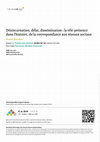
Le Temps des Médias, 2018
Comparant de façon systématique trois dimensions de la communication à distance : la désincarnat... more Comparant de façon systématique trois dimensions de la communication à distance : la désincarnation (versus la présence physique), le délai (versus l’instantanéité), et la dissémination (versus le dialogue privé), l’article montre les continuités qui unissent les réseaux sociaux numériques aux technologies précédentes, principalement l’épistolaire. L’histoire n’est pas linéaire, ne suggère ni progrès de la communication, ni perte d’authenticité. Les attitudes par rapport à la présence médiatisée ont été, d’emblée, profondément ambivalentes.
Proposing a systematic comparison of three dimensions of interpersonal communication at a distance : disembodiment (versus physical presence), delay (versus instantaneity) and dissemination (versus private dialogue), the article focuses on the continuities between social digital networks and former communication technology, mainly the epistolary. Suggesting neither progress and better communication, nor a loss of authenticity, our history does not appear as linear. Attitudes vis-à-vis mediated presence have been, from the start, deeply ambivalent.
From the book: Digital Roots, edited by G. Balbi, N. Ribeiro, V. Schafer, C. Schwarzenegger, 2021
This book chapter historicizes the notion of telepresence, a term coined in 1986. After defining ... more This book chapter historicizes the notion of telepresence, a term coined in 1986. After defining the different forms of telepresence, it shows that, much before computers and virtual reality, old technologies such as correspondence and painting have been used to provide a sense of social telepresence (being with) or spatial telepresence (being there, far away). It suggests a research program for this specific narrative of media history
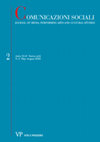
Comunicazioni Sociali. Journal of Media, Performing Arts and Cultural Studies, 2020
OPEN ACCESS. From a sociological point of view, this is a truly challenging time: a time of ‘reve... more OPEN ACCESS. From a sociological point of view, this is a truly challenging time: a time of ‘revelation’ as well as possible ‘revolution’, capable of revealing many of the pathologies of our lifestyle. The Corona- virus crisis has exposed the way our society works in a sort of a global social experiment, which provides the opportunity to question many of the categories and paradigms of our disciplines, as well as our way of life. More profoundly, the virus has exposed the structural tensions at the basis of our social, economic, political life. Our duty as intellectuals, as teachers, and as academics is today to find a way to inhabit this tension in a more integral, inclusive, fair way rather than to dream to solve it by removing or suppressing one of the aspects at play. It is therefore necessary to explore the many possible ways to exit this situation, transforming this crisis into an opportunity for positive change. This polyphonic article, stemming from a moment of common discussion kept online, aims to be a contribution to this effort.
Media theory: mediatization, liveness by Jerome Bourdon
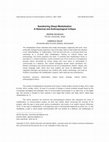
International Journal of Communication, 2021
The mediatization thesis maintains that media technologies, beginning with print, have profoundly... more The mediatization thesis maintains that media technologies, beginning with print, have profoundly changed human experience. One of its major claims is that media have allowed a new "disembedding," or "distanciation," from the here and now, in a process which now culminates as a so-called deep mediatization. Relying on cultural history and anthropology, this article questions this claim. It contends that mediatization theory is premised on a modern/naturalist, human-centered view of the world as a homogeneous physical nature, dominated by human beings who must resort to technologies to communicate at a distance. This outlook disregards ancient and/or peripheral non-Western ontologies, and cultural practices such as correspondence, theater, religion, and human language itself, which have long enabled rich forms of distanciation. Such neglected ontologies and practices now combine with modern technology, and could be fruitfully incorporated into mediatization research, both historical and contemporary.

This article makes the case for a comparative approach to communication technologies throughout h... more This article makes the case for a comparative approach to communication technologies throughout history, arguing that various types of comparisons could enrich both historical research and technology theorization. The article proposes a critical typology of five categories of comparison: The deterministic category compares the supposedly direct effects of major changes in communication technology; the all-encompassing category integrates technologies into wider evolving complexes where various technologies interact; the discursive category examines the utopian and dystopian discourses accompanying technological changes, and their power to shape technology; the deconstructing categpry contrasts distinct phases in the history of a supposedly singular technology; and the one-dimensional category focusses on a single social domain to see how it has been transformed by different technological changes.
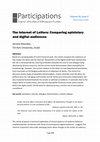
Participations. Journal of Audiences and Reception Studies , 2019
Based on a growing body of recent historical work, this article compares the audiences of two med... more Based on a growing body of recent historical work, this article compares the audiences of two media: the letter and the Internet. Researchers of the digital world have claimed that the net is characterized by a blurring of borders between the one-to-one dialogue (long idealized by literary research), and the one-to-many dissemination (best exemplified by broadcasting). However, the ancient medium of the letter too had long blurred boundaries, from local leaks to full-fledged publications of collections of letters. The article first discusses various types of epistolary disseminations, mainly voluntary ones (for glory, for political aims, for managing communities and for family and community relationships), but also involuntarily disseminations for private or political surveillance. It concludes that in the longue durée of media history, the Internet exemplifies historical trends which started before the digital world: the demand for absolute privacy, and the risk of total political surveillance.
Media, Culture and Society, 2000

This is a case study of transnational activism across media genres and platforms,
focusing on yo... more This is a case study of transnational activism across media genres and platforms,
focusing on young Israeli adoptees from Brazil, struggling to trace their biological
origins, recover (to some extent) their culture of birth and make their plight known.
Theoretically speaking, this study is based on the notion of hybridity, understood as a
strategy used by individuals to elaborate new social identities (Israeli adoptees organized
as online support group, moving to activism, recovering their culture of origin through
media and travelling), by media producers to elaborate texts relevant to complex
audiences (dramatized documentary, transnational ‘docu-telenovela’, Brazilian primetime
entertainment programme used to expose social problems), and more generally,
as a characteristic of the media system that constantly (re)combines technologies,
genres and actors. Hybridity, however, should not be confused with equality. Relations
between system components are mostly asymmetrical, but are constantly evolving,
often unpredictably, offering some manoeuvrability even for weaker actors.
Communication, Culture & Critique
Since the late 1990s, actor Ricardo Darin has been a key figure in the Argentinian film industry,... more Since the late 1990s, actor Ricardo Darin has been a key figure in the Argentinian film industry, and its most recognizable face abroad. With an impressive career that began with " lowbrow " national television and made the leap to prestigious transnational coproduc-tions, Darin's unique journey to international stardom allows us to address important questions regarding current processes of star formation in globalized cultural industries. This article uses the case study as the basis for a broader argument about the main discursive devices and marketing strategies that encourage or impede the reception and consumption of peripheral stars in different geopolitical regions. Stardom beyond the Hollywood system is a multilayered construction of sometimes contradictory discourses regarding national, regional, ethnic, and cultural–historical identities.

Journal of Modern European History, 2012
The new media of the twentieth and twenty-first centuries present particular challenges to histor... more The new media of the twentieth and twenty-first centuries present particular challenges to historians. To what extent have historians taken these challenges on board, and what remains to be done? Where are the gaps in current scholarship, and what are the most promising avenues for future research? In order to stimulate discussion, the Journal of Modern European History invited four experts to respond to these questions: Michael Meyen (Munich), Jérôme Bourdon (Tel Aviv/ Paris), Frank Bösch (Potsdam) and Lynn Spigel (Chicago). As this journal issue attempts to build bridges and facilitate dialogue between the fields of history, mass communication and media and television studies, to a certain extent, these distinguished scholars represent their academic fields. Lynn Spigel's works are well known in the world of television Studies. Michael Meyen's research is part of the historically focused strand of German communication studies, while historians Frank Bösch and Jérôme Bourdon have contributed to our understanding of how mass media shape long-term societal and political developments. The four statements offer intriguingly different perspectives on the future of media history, introducing us to the key concepts and writings in each field along the way.
Representing Israel-Palestine by Jerome Bourdon
Questions de Communication
Ce document a été généré automatiquement le 7 juillet 2024. Le texte seul est utilisable sous lic... more Ce document a été généré automatiquement le 7 juillet 2024. Le texte seul est utilisable sous licence CC BY-NC-ND 4.0. Les autres éléments (illustrations, fichiers annexes importés) sont « Tous droits réservés », sauf mention contraire.
Le Monde, 2024
L'historien et sociologue Jérôme Bourdon analyse le traitement de la guerre à Gaza dans les média... more L'historien et sociologue Jérôme Bourdon analyse le traitement de la guerre à Gaza dans les médias israéliens. Un traitement qui, selon lui, exclut toute responsabilité israélienne dans le conflit. Propos recueillis par Stéphanie Le Bars Publié aujourd'hui à 10h17, modifié à 14h21 Jérôme Bourdon, historien et sociologue des médias, vit en Israël depuis 1997. Il analyse pour Le Monde la manière dont les télévisions et les journaux israéliens couvrent l'offensive en cours à Gaza, et l'impact de leur travail sur la société.
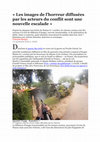
Médiapart, 2023
« Les images de l'horreur diffusées par les acteurs du conflit sont une nouvelle escalade » Depui... more « Les images de l'horreur diffusées par les acteurs du conflit sont une nouvelle escalade » Depuis les attaques terroristes du Hamas le 7 octobre, les réseaux sociaux sont des vecteurs à la fois de diffusion d'images, souvent insoutenables, et de polarisation du débat. Dans ce contexte, quels obstacles rencontrent les médias dans leur récit ? Entretien avec Jérôme Bourdon, historien et sociologue. François Bougon 14 novembre 2023 à 10h52 DansDans la guerre des récits en cours sur la guerre au Proche-Orient, les autorités israéliennes diffusent un film de quarante-cinq minutes composé d'images filmées le 7 octobre par les bourreaux du Hamas et les victimes. Des journalistes ou personnalités publiques, que ce soit en Israël ou ailleurs-en France, des projections ont été organisées par l'ambassade d'Israël en France-, ont pu le voir. Mardi à l'Assemblée nationale, le député Mathieu Lefèvre, président du groupe d'amitié France-Israël et défenseur d'un « soutien inconditionnel » à Israël, a décidé de projeter ce film (lire l'interview de son homologue Éric Bothorel qui est opposé à cette initiative). Agrandir l'image : Illustration 1 © Capture d'écran d'une vidéo diffusée par le Hamas
AOC. Analyses Opinions Critiques, 2023
Comment le débat public en est-il arrivé à faire du terme « colon » et de ses dérivés un enjeu po... more Comment le débat public en est-il arrivé à faire du terme « colon » et de ses dérivés un enjeu politico-médiatique ? Retracer l’histoire du terme est nécessaire pour parvenir à en faire un outil de savoir et un usage prudent.
AOC (Analyses Opinons Critiques). , 2023
Malgré de profondes divisions, la lutte pour une démocratie, même imparfaite, et contre le « coup... more Malgré de profondes divisions, la lutte pour une démocratie, même imparfaite, et contre le « coup d’État judiciaire » du gouvernement Nétanyahou agite Israël depuis maintenant plus de six mois. Mais quid du combat contre l’occupation et de la place des « Arabes israéliens » ? Pour la gauche anti-occupation, rendre justice aux Palestiniens, depuis l’intérieur des territoires, serait le meilleur moyen de restaurer une véritable démocratie.

Chapter from a book edited by T.Chaplin and J.Pieper Mooney, The Global 1960s, Convention, contes... more Chapter from a book edited by T.Chaplin and J.Pieper Mooney, The Global 1960s, Convention, contest and counterculture, Routledge. I focus on news and current affairs, with occasional consideration of other genres. Before 1967, in the Western world and some parts of the Third World, Israel enjoyed a positive image and succeed in "exporting" its national ideology justifying the creation of the state of Israel (often presented as a re-birth). However, the quick rebirth of antisemitism in old (catholicism in Latin America, e.g.) and new (Soviet first uses of antizionism hiding antisemitism, and the influence of the Soviet Union much beyond its borders) complicated the picture. The 1967 Six-Day-War was a turning point leading to a reevaluation of the image: Israel can now be judged in the context of decolonisation, and the Palestinians slowly start to get media attention, with an image no less complex than that of Israel.

This research is based on an ethnographic investigation of foreign press correspondents
working ... more This research is based on an ethnographic investigation of foreign press correspondents
working in Israel–Palestine. It strives to understand how the work of these correspondents
is linked to a network of changing and overlapping collective identities, be they national
or ethnic, for both journalists and their audiences. This is analyzed at three levels: (1)
just as the Western world is politically divided in respect to this conflict, so too is the
journalistic world, where suspicion of pro-Palestinism or pro-Israelism is voiced, albeit
mezza voce or off the record; (2) the journalists feel professionally challenged when their
impartiality is questioned due to their own religious or ethnic identities; and (3) finally,
audiences have changed, through a revival of ethnic and religious identities, overlapping
political involvement in the conflict, and technology which makes surveillance and ‘media
monitoring’ much easier. This form of ‘diasporic nationalism’ puts increasing pressure
on journalists.

Discourse and Communication, 2015
This article explores the debate that has surrounded the use of analogies in coverage of the
Isr... more This article explores the debate that has surrounded the use of analogies in coverage of the
Israeli–Palestinian conflict, analyzing in depth two ‘analogy affairs’ on the basis of a LexisNexis
corpus: the 2002 Auschwitz-Saramago affair (64 items) and the 2006–2007 Apartheid-Carter
affair (154 items). Using the classic Aristotelian tripartition of logos, ethos, and pathos, the
article unfolds the argumentative structure of the controversies. Carter and Saramago used the
combination of their own personal status and the controversial nature of their analogies to trigger
a debate. Commentators focused very much on the ethos (arguments around the authority
and the character of the authors) and the pathos, and tended to ignore the logos (the factual
relevance of the analogy). Opponents, who made up the majority of commentators, considered
analogies as a way of passing judgment on and mobilizing against one of the actors in the conflict
(Israel in our cases). This analysis suggests that despite the call for a more cautious use of (or
even a prohibition of) the analogies discussed, participants in the debate on the Israeli–Palestinian
conflicts are bound to resort to them – even if only to condemn them.

Uploads
Telepresence: history and theory by Jerome Bourdon
Proposing a systematic comparison of three dimensions of interpersonal communication at a distance : disembodiment (versus physical presence), delay (versus instantaneity) and dissemination (versus private dialogue), the article focuses on the continuities between social digital networks and former communication technology, mainly the epistolary. Suggesting neither progress and better communication, nor a loss of authenticity, our history does not appear as linear. Attitudes vis-à-vis mediated presence have been, from the start, deeply ambivalent.
Media theory: mediatization, liveness by Jerome Bourdon
focusing on young Israeli adoptees from Brazil, struggling to trace their biological
origins, recover (to some extent) their culture of birth and make their plight known.
Theoretically speaking, this study is based on the notion of hybridity, understood as a
strategy used by individuals to elaborate new social identities (Israeli adoptees organized
as online support group, moving to activism, recovering their culture of origin through
media and travelling), by media producers to elaborate texts relevant to complex
audiences (dramatized documentary, transnational ‘docu-telenovela’, Brazilian primetime
entertainment programme used to expose social problems), and more generally,
as a characteristic of the media system that constantly (re)combines technologies,
genres and actors. Hybridity, however, should not be confused with equality. Relations
between system components are mostly asymmetrical, but are constantly evolving,
often unpredictably, offering some manoeuvrability even for weaker actors.
Representing Israel-Palestine by Jerome Bourdon
working in Israel–Palestine. It strives to understand how the work of these correspondents
is linked to a network of changing and overlapping collective identities, be they national
or ethnic, for both journalists and their audiences. This is analyzed at three levels: (1)
just as the Western world is politically divided in respect to this conflict, so too is the
journalistic world, where suspicion of pro-Palestinism or pro-Israelism is voiced, albeit
mezza voce or off the record; (2) the journalists feel professionally challenged when their
impartiality is questioned due to their own religious or ethnic identities; and (3) finally,
audiences have changed, through a revival of ethnic and religious identities, overlapping
political involvement in the conflict, and technology which makes surveillance and ‘media
monitoring’ much easier. This form of ‘diasporic nationalism’ puts increasing pressure
on journalists.
Israeli–Palestinian conflict, analyzing in depth two ‘analogy affairs’ on the basis of a LexisNexis
corpus: the 2002 Auschwitz-Saramago affair (64 items) and the 2006–2007 Apartheid-Carter
affair (154 items). Using the classic Aristotelian tripartition of logos, ethos, and pathos, the
article unfolds the argumentative structure of the controversies. Carter and Saramago used the
combination of their own personal status and the controversial nature of their analogies to trigger
a debate. Commentators focused very much on the ethos (arguments around the authority
and the character of the authors) and the pathos, and tended to ignore the logos (the factual
relevance of the analogy). Opponents, who made up the majority of commentators, considered
analogies as a way of passing judgment on and mobilizing against one of the actors in the conflict
(Israel in our cases). This analysis suggests that despite the call for a more cautious use of (or
even a prohibition of) the analogies discussed, participants in the debate on the Israeli–Palestinian
conflicts are bound to resort to them – even if only to condemn them.
Proposing a systematic comparison of three dimensions of interpersonal communication at a distance : disembodiment (versus physical presence), delay (versus instantaneity) and dissemination (versus private dialogue), the article focuses on the continuities between social digital networks and former communication technology, mainly the epistolary. Suggesting neither progress and better communication, nor a loss of authenticity, our history does not appear as linear. Attitudes vis-à-vis mediated presence have been, from the start, deeply ambivalent.
focusing on young Israeli adoptees from Brazil, struggling to trace their biological
origins, recover (to some extent) their culture of birth and make their plight known.
Theoretically speaking, this study is based on the notion of hybridity, understood as a
strategy used by individuals to elaborate new social identities (Israeli adoptees organized
as online support group, moving to activism, recovering their culture of origin through
media and travelling), by media producers to elaborate texts relevant to complex
audiences (dramatized documentary, transnational ‘docu-telenovela’, Brazilian primetime
entertainment programme used to expose social problems), and more generally,
as a characteristic of the media system that constantly (re)combines technologies,
genres and actors. Hybridity, however, should not be confused with equality. Relations
between system components are mostly asymmetrical, but are constantly evolving,
often unpredictably, offering some manoeuvrability even for weaker actors.
working in Israel–Palestine. It strives to understand how the work of these correspondents
is linked to a network of changing and overlapping collective identities, be they national
or ethnic, for both journalists and their audiences. This is analyzed at three levels: (1)
just as the Western world is politically divided in respect to this conflict, so too is the
journalistic world, where suspicion of pro-Palestinism or pro-Israelism is voiced, albeit
mezza voce or off the record; (2) the journalists feel professionally challenged when their
impartiality is questioned due to their own religious or ethnic identities; and (3) finally,
audiences have changed, through a revival of ethnic and religious identities, overlapping
political involvement in the conflict, and technology which makes surveillance and ‘media
monitoring’ much easier. This form of ‘diasporic nationalism’ puts increasing pressure
on journalists.
Israeli–Palestinian conflict, analyzing in depth two ‘analogy affairs’ on the basis of a LexisNexis
corpus: the 2002 Auschwitz-Saramago affair (64 items) and the 2006–2007 Apartheid-Carter
affair (154 items). Using the classic Aristotelian tripartition of logos, ethos, and pathos, the
article unfolds the argumentative structure of the controversies. Carter and Saramago used the
combination of their own personal status and the controversial nature of their analogies to trigger
a debate. Commentators focused very much on the ethos (arguments around the authority
and the character of the authors) and the pathos, and tended to ignore the logos (the factual
relevance of the analogy). Opponents, who made up the majority of commentators, considered
analogies as a way of passing judgment on and mobilizing against one of the actors in the conflict
(Israel in our cases). This analysis suggests that despite the call for a more cautious use of (or
even a prohibition of) the analogies discussed, participants in the debate on the Israeli–Palestinian
conflicts are bound to resort to them – even if only to condemn them.
Anthropology of the body; naturalist ontology; liveness; emotions; authenticity; scientific imagery
‘This collection is a most comprehensive book on television ratings systems. It offers a remarkable breadth of case studies of nations from North and South America, Europe, and Asia. These also include a wide variety of types of measurement practices and organizational structures. Such an array offers great opportunities for comparative analyses. Just as important, the book is theoretically, analytically and critically sophisticated. It examines the various critiques of audience measurement, such as the important distinction between substantive and procedural truths and the underlying assumptions in quantification and statistics about human behavior and social relations.’
Table of contents:
Jérôme Bourdon and Cécile Méadel. Deconstructing the Ratings Machine. An Introduction.
PART I: Inventing Measurement
1. Stefan Schwarzkopf The Politics of enjoyment. Competing audience measurement systems in Britain, 1950-1980
2. Marc Balnaves Still the British model? The BARB versus Nielsen
3. Philip Savage & Alexandre Sévigny Canada’s audience massage. Audience research and TV policy development, 1980-2010
4. Jérôme Bourdon and Cécile Méadel The monopoly that won't divide. France’s Médiamétrie
5. Susanne Vollberg Pioneering the peoplemeter. German public service
PART II: APPROPRIATING AUDIENCE FIGURES
6. Santanu Chakrabarti Power games: audience measurement as a mediation between actors in India
7. Esther Hamburger, Heloisa Buarque de Almeida, and Tirza Aidar Imagining audiences in Brazil: class, “race” and gender
8. Massimo Scaglioni From referee to scapegoat, but still referee. Auditel in Italy.
9. Mark Balnaves Domestication of Anglo-Saxon conventions and practices in Australia
10. Elena Johansson and Sergey Davydov Market requirements and political challenges. Russia between two worlds
PART III: CONFRONTING CHANGES
11. Ann-Marie Murray The role of ratings in scheduling. Commercial logics in Irish public television
12. Philip Napoli The local peoplemeter, the portable peoplemeter, and the unsettled law and policy of audience measurement in the US
13. Katrien Berte & Tom Evens Challenges of digital innovations. A set-top box based approach
14. Jakob Bjur Thickening behavioral data. New uses of ratings for social sciences.
of audience face while taking stock of recent developments in the field. It starts with a definition
of the audience as an entity with both objective and subjective dimensions. It refutes the textualist
claim according to which audiences are pure discursive entities. Put into historical perspective,
textualism appears as less postmodern than romantic. This article then warns historians against
another form of less conscious, ‘rampant textualism’: being influenced by ‘grand narratives’
based on axiologies of hopes and fears triggered by the media. They may provide interesting
ideal-types but should not be considered as directly relevant to history. The main part of this
article is devoted to a typology of sources, following four categories: from above (coming from
media, political, administrative elites), from the side (references to audiences in other media,
including art and literature), from below (written and more recently oral expressions of audience
members) and from the media themselves (both physical artefacts and media messages). It shows
the advantages and drawbacks of each and explains the danger of pitching one against the other
(e.g. ‘good’ ethnography, against ‘bad’ statistics).
Abstract: This article explores the debate that has surrounded the use of analogies in coverage of the Israeli-Palestinian conflict, analyzing in depth two " analogy affairs " on the basis of a Lexis-Nexis corpus: the 2002 Auschwitz-Saramago affair (55 items) and the 2006-2010 Apartheid-Carter affair (144 items). Using the classic Aristotelian tripartition of logos, ethos and pathos, the article unfolds the argumentative structure of the controversies. Carter and Saramago used the combination of their own personal status and the controversial nature of their analogies to trigger a debate. Commentators focused very much on the ethos (arguments around the authority and the character of the authors) and the pathos, and tended to ignore the logos (the factual relevance of the analogy). Opponents, who made up the majority of commentators, considered analogies as a way of passing judgment on and mobilizing against one of the actors in the conflict (Israel, in our cases). This analysis suggests that, despite the call for a more cautious use of (or even a prohibition of) the analogies discussed, participants in the debate on the Israeli-Palestinian conflicts are bound to resort to them – even if only to condemn them.
Quella che emerge è una storia avvincente, caratterizzata da importanti somiglianze e altrettante differenze, che riguardano, per esempio, i modi in cui i diversi sistemi televisivi hanno affrontato cambiamenti epocali come la de-regolamentazione, l’avvento delle reti commerciali, la sfida dell’Auditel e dei sistemi di quantificazione del pubblico, la circolazione internazionale dei format e la progressiva ‘americanizzazione’ della cultura popolare del Vecchio Continente. Se, nonostante qualche tentativo non sempre pienamente riuscito, è difficile individuare una ‘televisione europea’, non di meno l’Europa è stata in grado di partorire una forma di televisione del tutto peculiare: pur con tutta la sua fragilità, qui è nata e si è sviluppata una nozione che ha fortemente inciso sulle culture e sugli immaginari. Se la storia del servizio pubblico europeo può finalmente essere tracciata, il suo destino resta tuttora incerto. Questo libro consente di capire perché, nonostante gli attacchi che provengono da ogni parte, il servizio pubblico merita di essere difeso e rilanciato.
Dans l’évolution des médias français, l’époque fait charnière. Les questions sont multiples. Politiques avec la croyance dans le pouvoir absolu de la télévision, sociologiques quand le medium envahit tous les foyers, culturelles alors que s’inventent un nouveau langage, une nouvelle imagerie populaire, professionnelles enfin avec des métiers nouveaux qui s’organisent dans l’univers particulier d’une institution publique, l’ORTF.
Comme l’écrivait Jean-Pierre Rioux lors de la sortie de la première édition de cet ouvrage, ce « retour sur la décennie gaullienne de la Cinquième République fournit un bon prétexte très argumenté pour une réflexion rétrospective, aujourd’hui, sur l’avenir de la télévision ». Et in concluait : « Ce livre indispensable nous manquait cruellement ». Le voici à nouveau disponible !
The articles in this issue focus on the contribution of European television researchers, covering all three areas of media studies (production, text and reception), and touch upon a broad range of topics including: the reconstruction of the national past after regime changes (in both Southern and Eastern Europe); competing versions of the “same” past; the fragile fostering of a European identity; and the regional/would be national past. The issue emphasizes the different uses (ethnographic, historical) of life-stories of television viewers and hints at the possible changes to memory formation brought about by television in the post-network, digital era. Finally, this issue charts the field of European television memories, but will also suggest ways it can be researched further, both nationally and transnationally.